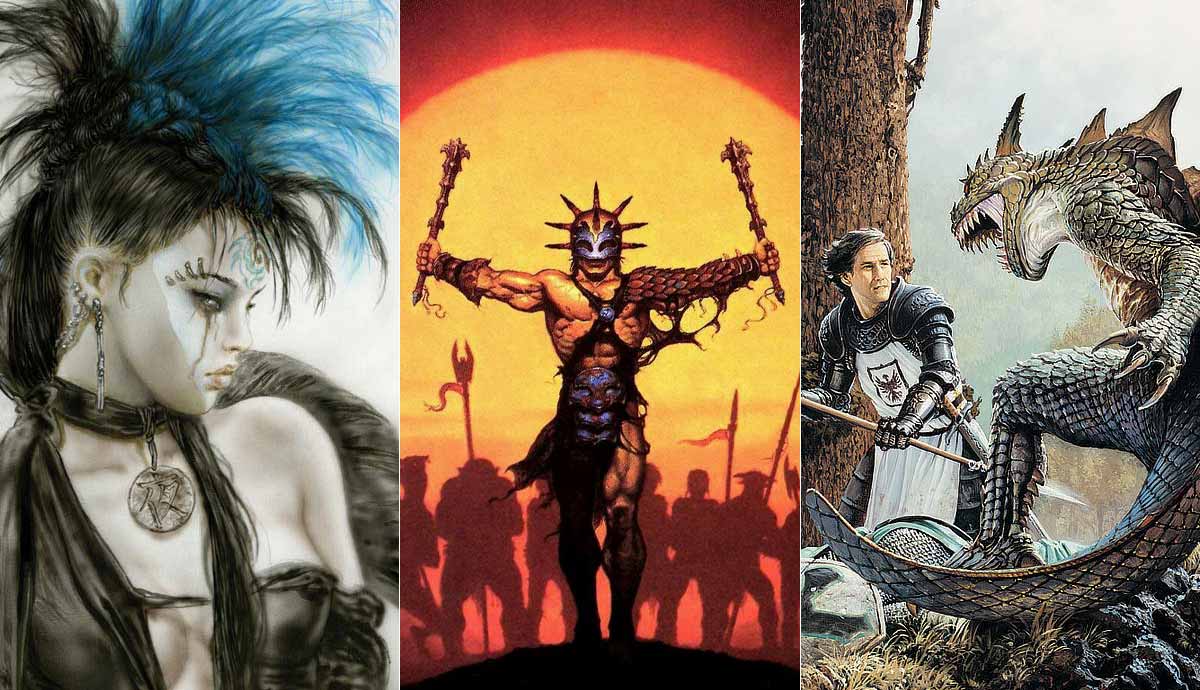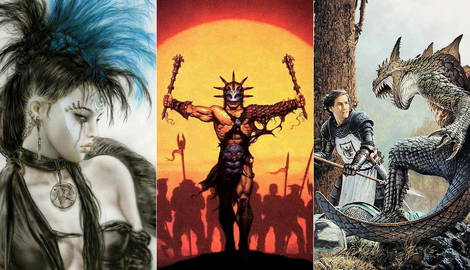
Fantasy art is an incredibly wide and varied genre. It draws from multiple elements and from many different cultures. It uses a variety of media, is used for a variety of purposes, and the subject matter can be vast. Unpacking this genre and understanding the movement is no small task. Despite its popularity, fantasy art is often seen as a niche market, but this couldn’t be further from the truth. Fantasy, across all media, is arguably the most popular genre. One only has to notice the readership and viewership statistics of The Lord of the Rings, Game of Thrones, and Harry Potter to realize that fantasy, and its accompanying art does not exist within a small bubble with a small cult following.
The art itself can be classified as fine art, as it fits the definition. The artists are talented, using palette and form to create otherworldly visions from the depths of their imaginations. Upon inspection of the masters of this genre, one cannot deny their skills with the brush! Here is the story of contemporary fantasy art, where it came from, and how it communicates its wild imagery to audiences across the world.
History of Contemporary Fantasy Art

Fantasy art is as old as art itself. The representation of deities and spirits is as old as cave paintings of our ancestors hunting mammoths. The imagery of the imagination, angels, demons, as well as benign and malevolent spirits, have been depicted from the dawn of civilization through the middle ages and the Renaissance right up to the present day. Today, there is a distinction between “fantasy art” and “fantastic art.” The former is defined as the domain of fantasy and science fiction, while the latter is loosely defined as the celebration of the imagination, other-worldliness, and even the grotesque. Defining artists according to these definitions is problematic in that there is often a very large overlap between the two movements. The art of Ian Miller is a perfect example of a crossover between fantasy, fantastic, and grotesque.

Like all art movements, there have been evolutions in themes and form. These evolutions are gradual, and as such, it is difficult to pinpoint an exact starting point for contemporary fantasy art. Nevertheless, it is salient to identify the foundations for what we have now. Arthur Rackham (1867-1939) is undeniably an important figure in that he moved the genre of fantasy art out of folk drawings done by peasants for hundreds of years into a commercial realm with an audience belonging to the mainstream of society.
Arthur Rackham’s illustrations feature a host of sentient, non-human creatures, which are a common staple (and defining feature) of fantasy art. Like later contemporary fantasy art, Rackham’s body of work is mostly the result of commissioned art designed for certain publications.

In the latter half of the 19th century, contemporary fantasy art was kickstarted by pulp fiction, which was widely consumed, and the covers became popular among a “lower class” audience. This audience, however, represented the popular masses rather than the elitist few who decided what constituted good art. From the pulp of the 1950s onwards, writers began writing full-length novels. Science fiction, in particular, became massively popular. Artists followed suit and going from “low class” pulp covers to covers for actual novels was seen as an increase in prestige.

Of particular importance in this pulp fantasy craze were Robert E. Howard’s Conan stories, which captured the imaginations of many readers. Along with the stories came paintings of an impossibly muscled man draped in sexualized and servile women. Contemporary fantasy art (and Frank Frazetta, who painted the original Conan covers) also depicts strong heroines as the focus of the art. In fact, this depiction is far more popular than the depiction of women as slaves and fawning, starry-eyed girls enraptured by the hero’s masculinity. The element of sexualization, however, continues to be an important theme that has drawn support and criticism as debates around what constitutes feminine power are still very much an issue today. The works of Frank Frazetta were a defining feature of this era, as well as the art of Boris Vallejo and Julie Bell, among others.

Perhaps another argument is that women’s transformation in fantasy art from servile to dangerous women wielding swords and killing men and monsters changed a generation of boys’ preferences. In this particular sense, it can be argued that fantasy art helped emancipate women from traditional roles of subservience. This argument, however, does rely on “boys’ preferences” to determine the role of women. The depiction of women in fantasy art is, to say the least, complicated and fraught with reams of social commentary to unpack.

In 1977, the French magazine Métal Hurlant (Heavy Metal) was published in the United States and became a source through which fantasy artists and writers could showcase their work. The magazine was hugely popular and is still in print.

From the 1990s, contemporary fantasy art flourished through card games such as Magic: the Gathering. With thousands of cards, each one requiring a unique, high-quality image, there was plenty of employment for good fantasy artists. Other card games sprang up throughout the 1990s and into the next century.

The progress of computer graphics and software created a new medium that was easily accessible: digital art. The genre is now full of artists creating wonderfully imaginative creations through their computers, providing artwork for computer game content as well as for purely aesthetic consumption.
The Dungeons & Dragons Effect

The advent of Dungeons & Dragons had an explosive effect on society and the world of contemporary fantasy art. The tabletop game was limited only by the imagination of its creators and its players, and an important way of communicating the visions of imagination was to employ fantasy artists. As the game branched out, creating otherworldly settings, artists were challenged to create realistic (as opposed to surrealist) artwork that captured ambiances not found on earth. Imagine a world where the sky is a dusty yellow color or a city of jagged edges and rusty metal spires. Fantasy artists had to dig deep into their imaginative reservoirs to create atmospheres that had never been conceived or realized by artists before them or even by human beings. In a sense, much of this was and still is imaginative realism.

Dungeons & Dragons was only the tip of the iceberg. Many other companies started their own gaming systems and created their own worlds, all requiring vast quantities of skilled art to be produced. As a result, a massive slew of talented artists became recognized as masters of the genre. The audience, while playing their games, became aware of the art and the artists surrounding them. The fame of these artists was a byproduct of the industry rather than the established dynamic of art and fame to which other artists were subject.
What Constitutes Fantasy Within the Genre?

Contemporary fantasy art is an umbrella term that covers a wide variety of art. Traditional fantasy themes are mixed with science-fiction, symbolism, surrealism, realism, the grotesque and the horrific, through a wide range of media. Illustrations, oil paintings, digital art, and even sculpture have been used to project the themes.
Its subject matter is even more varied, from Tolkienesque orcs, wizards, elves, dragons, ogres, trolls, and other creatures, to otherworldly ambiance, fashion, activities, and scenes. The genre often exaggerates what is real, with muscle-bound men and beautiful women, although this is not always the case. There is also a heavy focus on good and evil, with heroic adventurers and malevolent villains being a popular theme.
Critiques & Rejections of Fantasy Art

Fantasy art is an oft-overlooked genre of art. It is not viewed with the same reverence that other art has accrued. Why this is is subject to much debate. Perhaps it is the content that has driven the attitudes of older generations to reject the mores of the younger generations. This is certainly a dynamic that is true across many subjects, and it is not consigned to art alone.
It is noteworthy to demonstrate fickleness within the community of art “connoisseurs.” The classic period viewed religious art as the highest endeavor and was regarded with great esteem. Nowadays, a painting of a religious theme rarely makes headlines unless it’s satirical or political. Similarly, serious religious art has been consigned to the realm of “folk art.” For contemporary fantasy art, what was considered “low-brow” is currently undergoing a shift in attitudes as generations of people grow older, and those who know and love fantasy art become leading figures in the commercial sector of the art world.

Fantasy art also incorporates a wide selection of erotic imagery into its corpus, and certain artists focus almost entirely on the sexualized female figure. Hugely successful artists such as Luis Royo and Dorian Cleavenger, among many others, are prime examples of this dynamic. Such depictions in art have, however, drawn criticism from more than one demographic, and much contemporary fantasy art is easily labeled as NSFW. With imagery that boldly crosses the lines of general social acceptability and with depictions going so far as to involve coitus (sometimes with non-human entities), the question arises as to whether certain works are considered fine art or simply smut. Maybe they are both. Either way, critiques devolve into accusations of contemporary fantasy art existing to fulfill male sexual desires, which is problematic in that contemporary fantasy art has many themes and should not be defined by only one of them.
Who are the Artists?

There are many seminal artists who are considered masters of their field. The list became long very quickly, and today the list is much, much longer as the genre has grown in popularity by way of commercial enterprise as well as for sheer pleasure.
Those who are familiar with the genre will, however, cite a few master artists as being at the foundation of contemporary fantasy art. Frank Frazetta, Boris Vallejo, Julie Bell, Larry Elmore, Keith Parkinson, Clyde Caldwell, Ian Miller, Dorian Cleavenger, Luis Royo, Gerald Brom, Jeffrey Catherine Jones, Michael Whelan, Todd Lockwood, Simon Bisley, Terese Nielsen, Ciruelo Cabral, Rowena Morrill, and Jeff Easley are just a few names in this solid core of the genre.

In contemporary fantasy art, subtlety is generally a foreign concept. Imagery is bold and provocative. It also presents an extremely varied array of subjects and forms. On one side of the spectrum, artists are rarely bound by accepted norms, and can incorporate sex and violence into their work. In this sense, contemporary fantasy art represents the freedom to explore the human imagination and condition in all its glory as well as its depravity. On the other side of the spectrum, fantasy art can also incorporate humor, cuteness, and whimsy that is endearing to the viewer.
Painting contemporary fantasy art with a single brush is thus an erroneous enterprise. It is a genre that requires careful analysis rather than a snap judgment. And with careful analysis comes the appreciation of composition, brush skill, understanding colors, and an ability to evoke emotions through imagery foreign to the viewers’ lived experiences.










